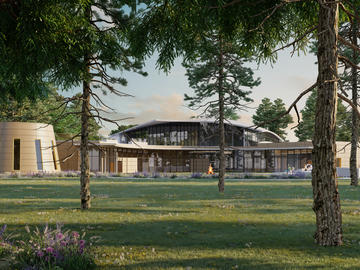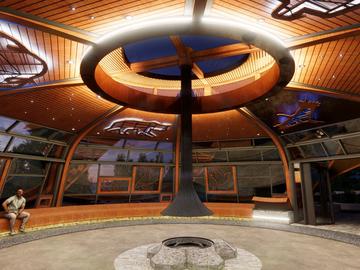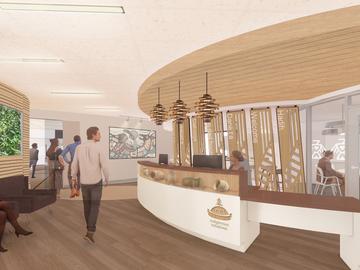
Productive disruption: On a mission to recreate space and programming from an Indigenous lens
Wanda Dalla Costa is Canada’s first female First Nations architect. But her impact on the world through design and education deserve recognition beyond gender or ethno-specific qualifiers. She is simply a remarkable person dedicated to work that reflects her values. Unfettered by the expectations of others.
A native Albertan and UCalgary alum who lives and works in Arizona, Dalla Costa’s name appears regularly across design newsfeeds. She was named an Honourary Fellow of the Royal Architectural Institute of Canada in February. Her firm TAWAW Architectural Collective is one of the partners of the $240-million Arts Commons Transformation project in Calgary, and she was one of seven prominent Indigenous architects featured in Ron Chapman’s From Earth to Sky documentary.
She is successful, yes, but more than that she is notable because of her determination to question the design status quo, to forge a career path that dares to be different.
In September 2020, the School of Architecture, Planning and Landscape (SAPL) hosted a lecture, Equity in Design + Design Education, as part of a unique, collective effort by all Canadian design schools to create an online lecture series during a particularly vulnerable time. During his presentation, panelist Dr. Craig Wilkins remarked: “The age of the gentleman architect is over, the age of the activist architect has begun.”

Wanda Dalla Costa, MArch’02
Wilkins’ words galvanized what many designers had only begun to wrestle with: how to reimagine the role of design(ers) in the context of global and social challenges.
Dalla Costa, MArch’02, had been wrestling with similar ideas for the better part of two decades, since enrolling in a Master of Architecture degree at the University of Calgary. “I didn’t identify with what I was being taught in architecture school,” she recalls. “It was during a time when everyone was conforming to white boxes.”
White boxes were not part of Dalla Costa’s lived experience. Her primary notions of space, gathering and community were formed during summers and holidays at her grandmother’s house on the reservation. “There were 60 of us crammed into a house. Double outhouses. There was no running water. We were playing in the fields, climbing in the barns. It was such a beautiful and inspirational place. We lacked nothing.”
Prior to enrolling in architecture school, Dalla Costa backpacked around the world for seven years on a shoestring budget by working random jobs. Off the beaten path, she found people holding on to their cultural traditions and traditional ways of life. The spaces they used were connected to their values and life ways. She was enamored and inspired by curves, architecture made of bamboo and boulders, expressive roof lines and underground caves.
Her design school education did not align with what she’d seen and experienced on the reservation or in the 40 countries she’d visited during her travels. Rather than despair or quit, Dalla Costa had an astute revelation: “Just because I’m being taught in a certain direction doesn’t mean I can’t challenge it.”
That realization has defined her professional trajectory.
Throughout her career, Dalla Costa has followed her intuition, unwavering in the belief that there is another way to look at architecture.

Chippewa of the Thames First Nation Heritage Hub in Ontario.
Courtesy TAWAW Architecture Collective
“When I look at our firm and what we are aiming to do, I can’t just classify what I do as architecture,” she notes. “It’s ethnography, really — we create spaces of possibility, plurality, relationality, spatial agency and resilience. We look at cultural research and associated protocols.” In particular, Dalla Costa has learned about what successful co-creation should look like through the work of New Zealand’s Hirini Matunga, Paul Memmott and Cathy Keys’ work in Australia and Diébédo Francis Kéré’s work in Africa.
These designers redefine architecture through the lens of understanding and articulating the social and cultural values of the communities in which they design, making a case for more varied and broadly based voices in the field.
Dalla Costa also learns from fellow smaller-scale practitioners who look beyond the scenery to dig into who lived there, how they lived traditionally, what their value systems were and what they aspired to be. Because a space must be more than a pleasing aesthetic.
“That is an old way of looking at it,” Dalla Costa notes. “We need to bring a more broad, comprehensive, holistic view of what architecture really does and what it can be. It should impact the social, ecological, cultural, spatial, physical, emotional, spiritual and mental. It does so much more than we have given it credit for in the past.”
SAPL professor Dr. Graham Livesey served as Dalla Costa’s academic supervisor when she was a student working on an Indigenous community project in Edmonton. “Wanda Dalla Costa is one of the leading voices for Indigenous design and education in North America right now. It has been impressive to watch her career develop and to see the effect of her work as it begins to take hold in architectural schools in Canada and the U.S.”
In Calgary’s Arts Commons Transformation project, Dalla Costa’s firm is looking at traditional organization systems — the sharing circle, pow wow — to see if it could impact contemporary spaces. This extends to marking solstice and equinox in the way of old Indigenous architecture or honouring significant sites and the stories and songs that accompanied those places.
“Those elements of productive disruption — whether related to earth or how we recreate space and programming from an Indigenous lens — all of these are on the table for productively disrupting the city,” Dalla Costa asserts. “We’ve designed our cities based on what was done in [other places], but we never look to the [existing] place, to what happened in that place, what was special about that place and how to lift that up to re-create something hyper-local.”
Although Dalla Costa’s work is all about digging into the past and applying it to the present, she is very future-focused when it comes to mentoring and teaching the next generation of designers and educators.
She works with Arizona State University’s Indigenous Design Collaborative, training Indigenous people to become educators through mentoring, support and creating opportunities for them. At Tawaw, Dalla Costa trains staff in all the facets of a design business (marketing, accounting, management and project management) so they can be at an associate level within five years.
Dalla Costa understands first-hand the challenges of design curricula that connect only to European or Western traditions and feels strongly that design education needs to be more reflective and inclusive of more people. She’s also seen and experienced the disconnect in how admissions decisions are made, based on presuppositions of what it takes to be successful in the profession.
“I’m living proof — nobody in my family went to university — I didn’t have the qualifications, portfolio, the access, the means, or all of the generations of learning how to get into a university and how to be successful in a practice or profession or academia. I had to learn it all on my own. It’s why I’m so determined to mentor young students — I don’t want them to feel what I felt. There has to be another way to do this work in an equitable, inclusive and honourable way.”
Dalla Costa has received a staggering number of awards over the years, but none is as meaningful as seeing her mentees succeed. “Seeing the progress of the students I’m mentoring — to make it into teaching, practice, to see themselves as managers — that is all the reward I need in this profession.”
Wanda Dalla Costa will be officially inducted to the Royal Architectural Institute of Canada as an Honorary Fellow on Oct. 2, 2022.












